Are you thinking about converting a van into a campervan? One of the most important decisions you’ll make is the layout of your van. You’re probably asking, “What is the best layout for a campervan?”
The best campervan layout includes a comfortable sleeping area, a decent-sized kitchen, an eating area, a bathroom, and adequate storage. Driver and passenger chairs that swivel to provide an eating area or workspace.
Your campervan’s functionality and livability can be greatly affected by its layout. In this post, we will discuss the various layout options and assist you in selecting the most suitable layout for your requirements.
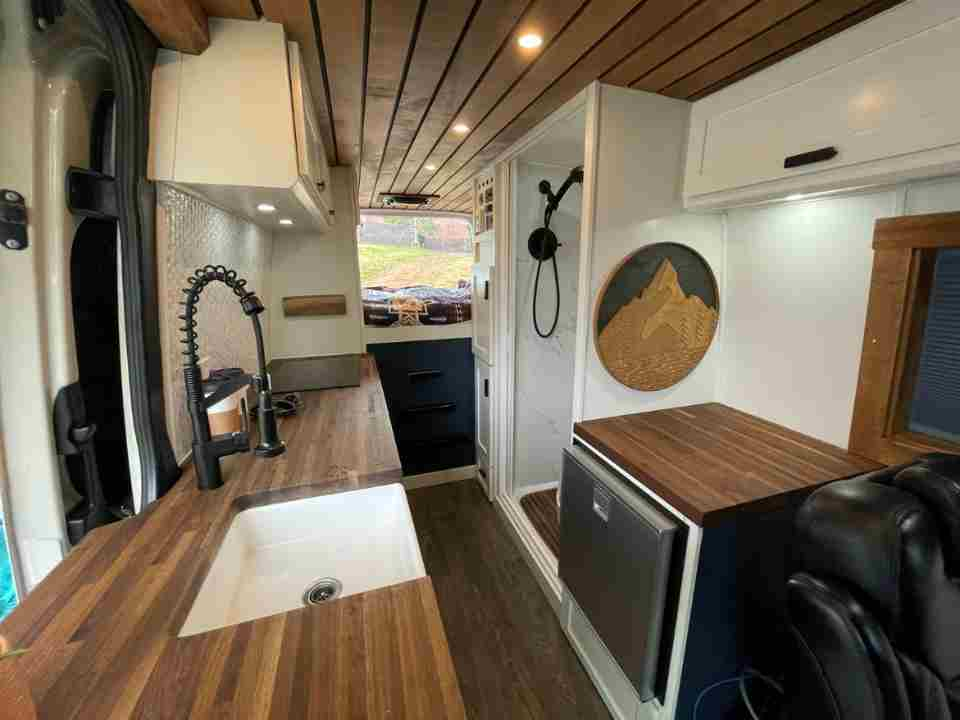
Floor Plans
Floor plans in camper vans; are as numerous as the stars. But what are some popular layouts for camper vans?
Rear-bed Layout
The rear-bed layout is one of the most common camper van layouts I’ve seen. Part of the reason is that there are so many options for putting the bed in the rear.
This layout is popular among people who prioritize sleeping space. It allows for a separate and dedicated sleeping area. This layout is suitable for people who like privacy and quiet while sleeping.
Because they provide a sleeping area distinct from the main living area, rear bed layouts are a popular choice for camper vans.
In this configuration, couples and families will appreciate this layout’s privacy and separation from the rest of the living area.
However, it does carve out more van space and may limit the size of your bed or available storage space. Also, you may need a ladder or steps seat to reach the bed.
| Pros | Easy to install |
| Cons | May limit storage space or bed space |
Rear-bath Layout
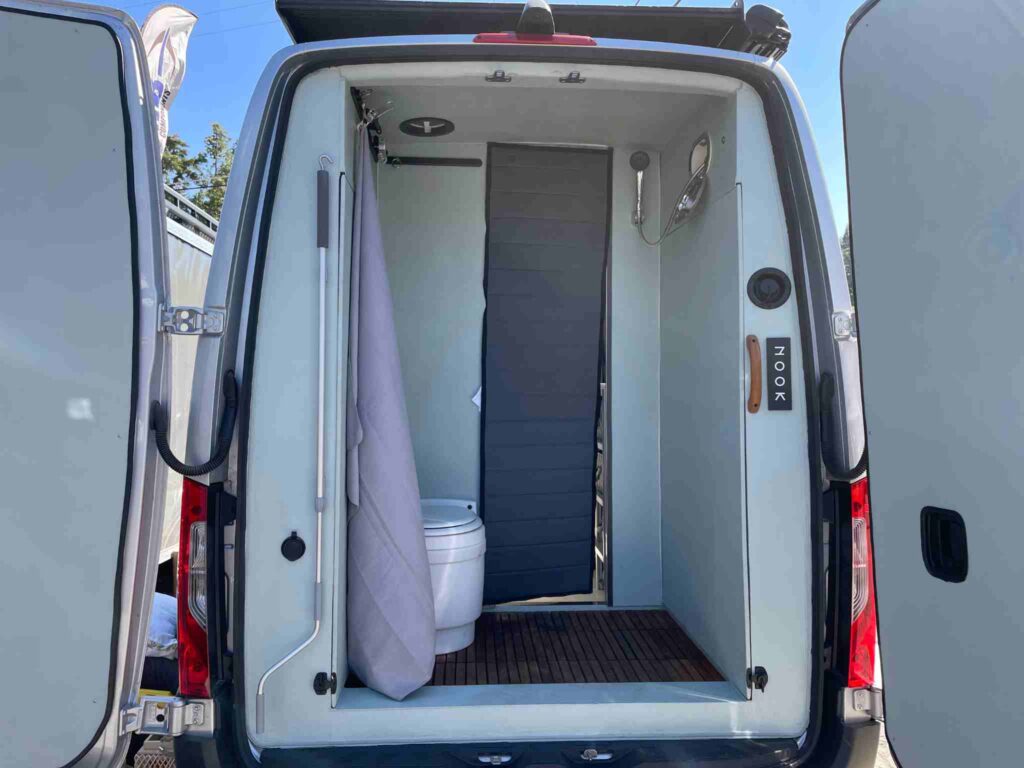
The rear bath layout is less popular because it utilizes much bathroom space. However, it’s very popular with people who enjoy water sports. Surfers, stand-up paddleboarders, and divers appreciate a rear bath. For them, having a rear bath makes it easier to get clean and warm.
This layout typically includes a bathroom with a shower and toilet in the van’s rear, separate from the main living and sleeping areas.
This can be especially appealing for couples or families, as it allows multiple people to use the facilities at once without disrupting the rest of the living space.
Additionally, having a private bathroom can make extended trips or living in the van full-time more comfortable. However, this layout can also be more space-intensive and may require additional plumbing or maintenance.
I wrote about bath layouts in this article.
| Pros | Accommodates a larger-size bathroom |
| Cons | It uses a large amount of the van’s footprint |
Rear Kitchen Layout
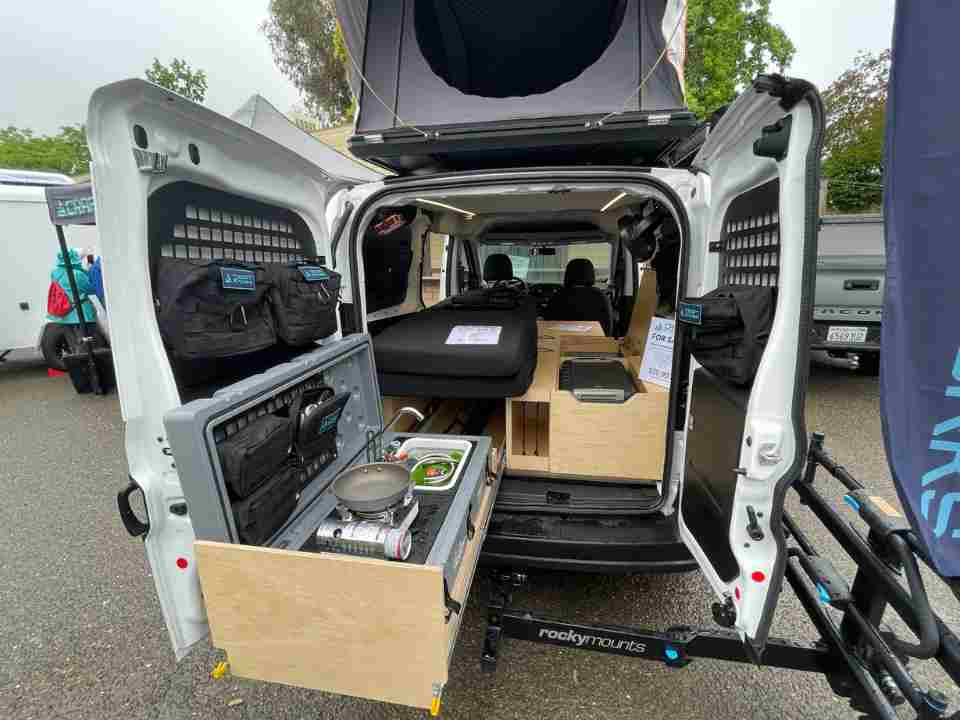
Overlanders and others who enjoy cooking outside prefer the rear kitchen layout. Accessing the kitchen outside is simple because it’s in the back of the van.
The kitchen is typically beneath the bed or dinette. A pull-out refrigerator, stove, and sink are all common features of many rear kitchens.
Additionally, it permits additional counter space and storage space for kitchen essentials. However, it requires more van space and may limit the amount of storage space in the van’s back. And accessing the kitchen inside the van may be inconvenient.
| Pros | Preferred by outdoor cooks |
| Cons | It takes up usable potential garage space |
Center Kitchen layout
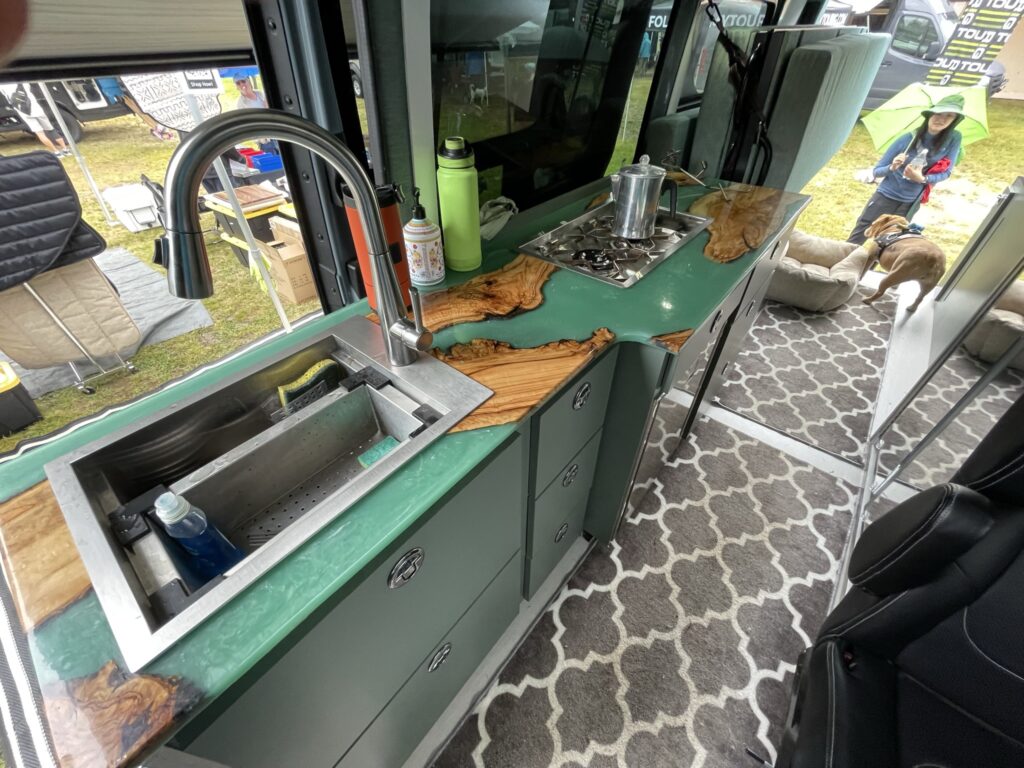
The center kitchen layout is the most popular for van builds. In this layout, the sink, stove, and refrigerator are located in the middle of the van. This layout provides easy access to the kitchen for meal preparation and clean-up, making it an excellent option for those who enjoy cooking and entertaining.
However, it does take up valuable floor space in the middle of the van and may limit the size of other living areas, such as seating or storage. Also, it may be more challenging to move around the van while someone is cooking.
One of the things I really like about this layout is that you can quickly stop while traveling, hop into the back of the camper, and make lunch.
This is an excellent option for those who prioritize cooking and meal preparation while on camper van trips.
| Pros | It makes for easy cooking stops |
| Cons | Dining area may be smaller, with limited seating |
Front Dinette Layout
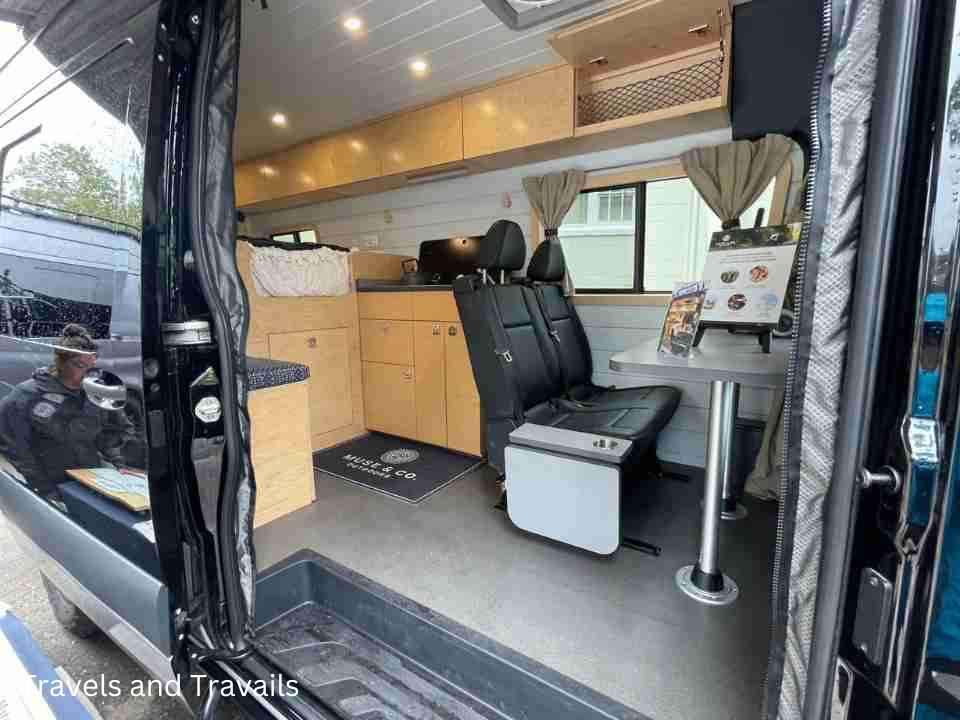
The front dinette layout utilizes the driver and passenger swivel seats or additional seating at the front of the van.
This layout is excellent for people who enjoy socializing and entertaining while on the road. The front dinette area can be used for meals, games, and even work and often includes a table that can be folded down or swiveled out of the way.
| Pros | Repurposes already an available driver and passenger seats |
| Cons | It may not accommodate as many people as a traditional dinette |
Dual Purpose layout
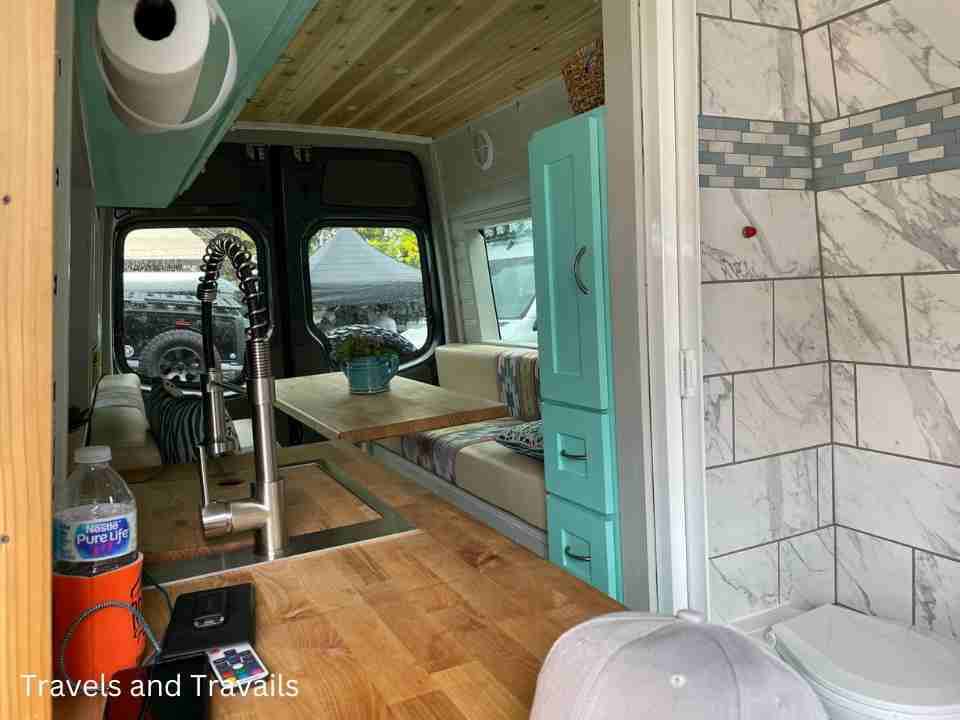
The duel-purpose layout has a seating area or dinette that can be converted into a bed. This layout is popular for its flexibility and efficient use of space but can be less comfortable than a dedicated sleeping area. We’ll talk more about this layout when we discuss beds next.
| Pros | It makes good use of space |
| Cons | The dining or bed area must be set up; the sleeping area may not be as comfortable |
Bed Options
Getting a good night’s sleep is crucial when you’re on the road. One of the most important decisions you’ll make when designing your campervan is where to put the bed. Here are a few different options to choose from.
Permanent bed
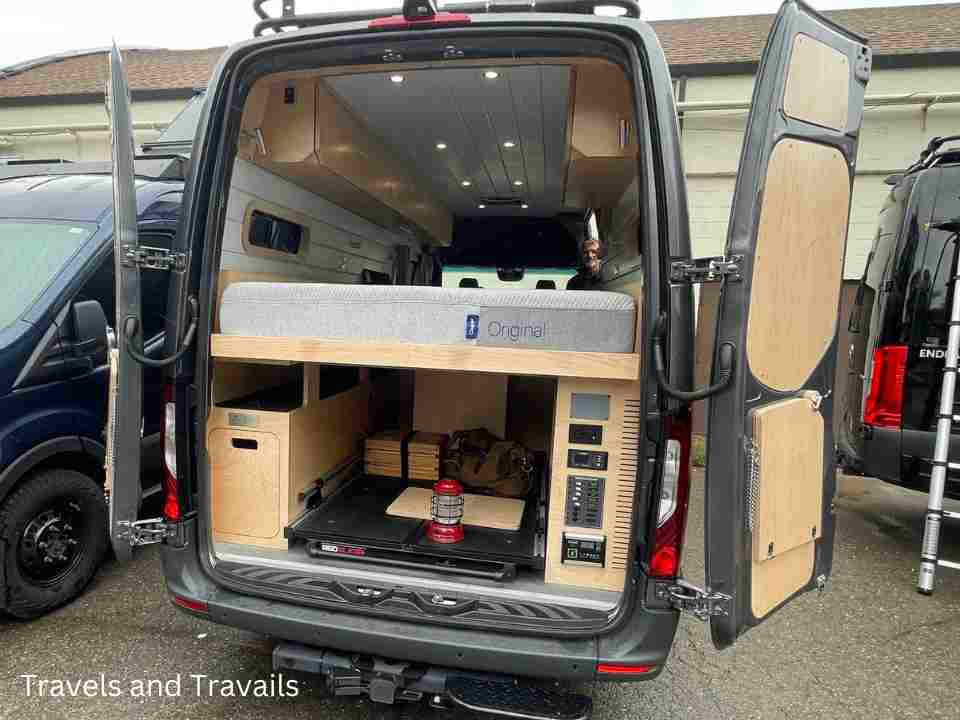
A permanent bed is a bed that is built into the campervan and cannot be taken out or converted into another space. This option is great for those who want to maximize sleeping space and don’t need the space for anything else.
A permanent bed layout is popular for campervans as it maximizes sleeping space and provides a comfortable and stable sleeping area. In this layout, the bed is built into the van and cannot be removed or converted into another space.
This means that the bed takes up a significant portion of the van’s interior, but it also means that you don’t have to worry about setting up or tearing down the bed each night.
One of the main benefits of a permanent bed layout is that it provides a stable and comfortable sleeping area. This is especially important for long-term travelers or those who plan to spend a lot of time on the road.
Additionally, a permanent bed can be customized to fit the van’s specific dimensions, allowing you to make the most of the available space.
A permanent bed layout also allows using a regular mattress instead of cushions.
On the other hand, a permanent bed layout can limit the flexibility of the van’s interior and may not be the best option for those who need to use the van for multiple purposes.
If you need the van to be able to change to a seating area or if you don’t want to be limited in terms of space, then this layout may not be the best fit for you.
| Pros | Provides a comfortable sleeping area |
| Cons | Does not allow for flexibility in the space |
Convertible bed
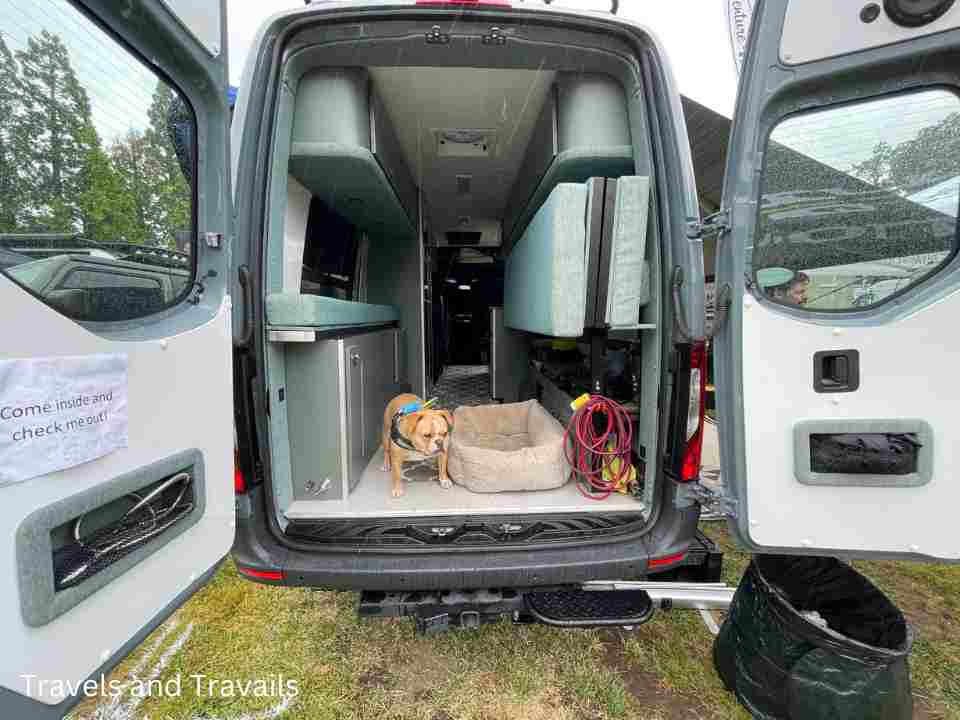
A convertible bed layout is another popular option for campervans It maximizes living space and provides flexibility in using the van.
One of the main benefits of a convertible bed layout is that it provides flexibility in using the van’s interior.
The bed can be converted into another space, such as a couch, dinette, or seating area in this layout. This means that when the bed is not in use, you can use the space for other purposes, such as eating, lounging, or even working.
With this option, you can easily switch between sleeping and living space, which is especially useful a such a small space. Additionally, a convertible bed can be customized to fit the specific dimensions of the van. This allows you to make the most of the available space.
On the other hand, a convertible bed layout can be less stable and less comfortable than a permanent bed. Convertible beds often utilize cushions or foam mattresses. These mattresses are not as comfortable as traditional mattress.
Additionally, converting the bed into another space can be time-consuming and requires additional hardware or equipment. It’s essential to weigh the pros and cons and determine if a convertible bed layout fits your needs.
| Pros | Allows flexibility of the space |
| Cons | May not be as comfortable as a traditional mattress |
Murphy bed
A Murphy bed can be folded up into the wall when not in use. This type of bed is a great space-saving solution for campervans. It allows you to have a comfortable sleeping area without sacrificing valuable living space.
The bed can be easily folded for use at night and put back up in the morning This clears up valuable floor space.
This bed system can be installed horizontally or vertically, depending on the space available in the van. It can be customized to match the interior design of the van.
Additionally, Murphy beds are available in various sizes, including twin, full, and queen.
This option is great for those who want to maximize space and like the flexibility of using the van for multiple purposes.
| Pros | Allows flexibility of the space |
| Cons | Can be cost prohibitive |
Platform bed
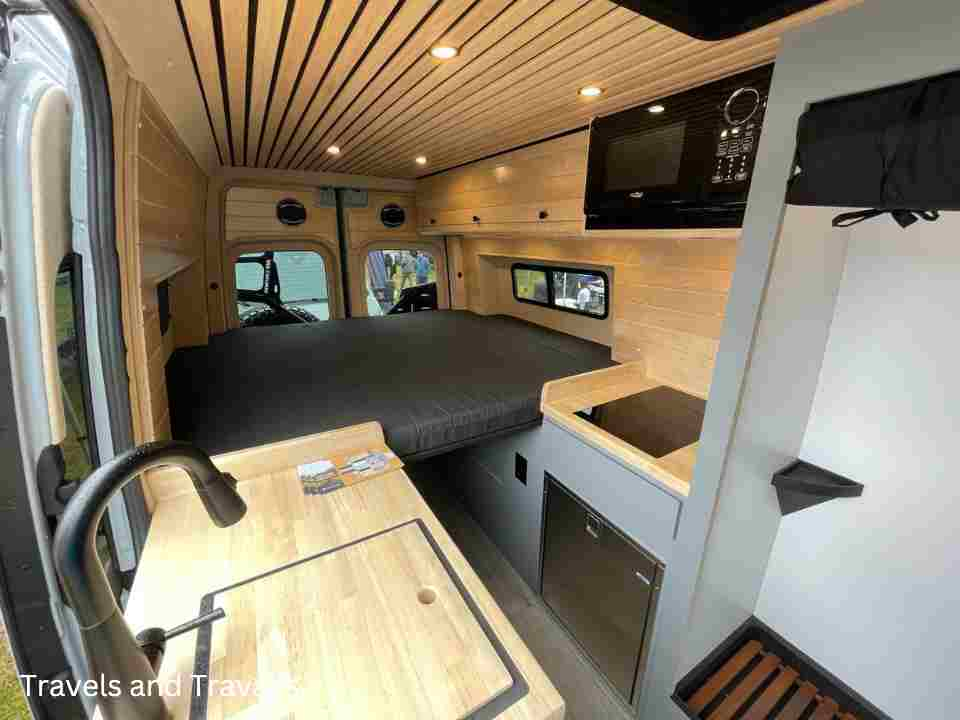
Platform beds are popular in campervans because they provide a sturdy and level sleeping surface. They are typically built using wood or metal and can be customized to fit the specific dimensions of the van.
Platform beds can be made to fit any size mattress and customized with storage underneath. They are great for those who want to maximize space. Plus, they eliminate the need for a separate bed frame and can be designed to include additional storage underneath.
Additionally, platform beds can be designed to be convertible, which means that the platform can be folded up to create more space during the day.
| Pros | Easy to install, economical |
| Cons | Does not allow flexibility in the space |
Drop-down bed
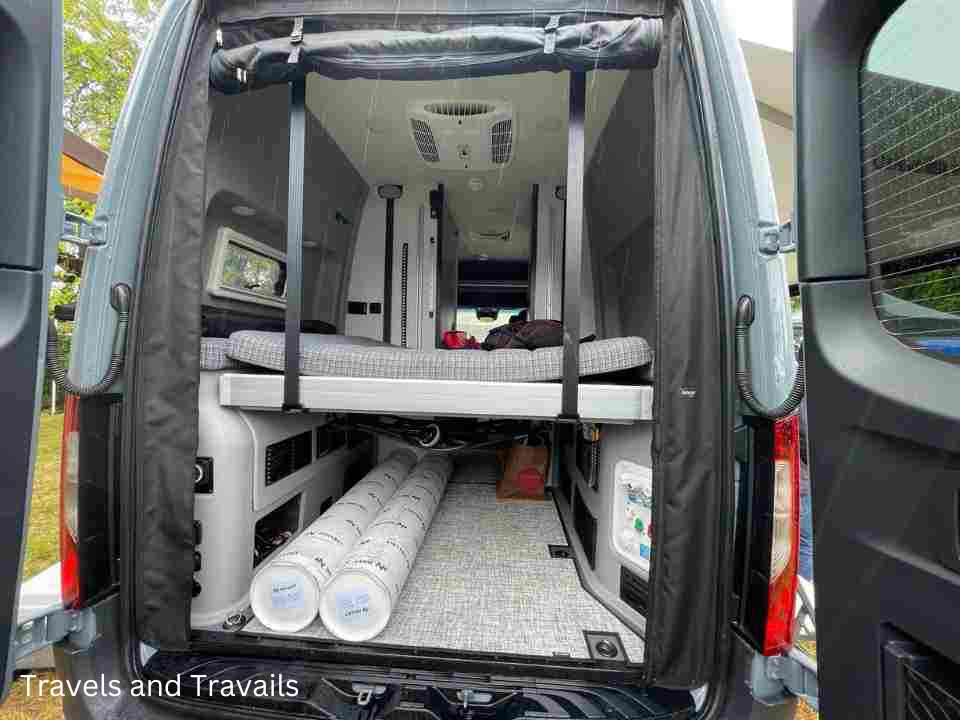
Drop-down beds are a type of bed layout that is mounted on the ceiling or wall of a campervan. They can be raised when not in use. They are an excellent option for vans that have limited space since they do not take up limited floor space.
This type of bed is excellent for those who want to maximize space, as it can be folded up when not in use to create more room for other activities.
Drop-down beds can be made to fit any size mattress and customized with storage underneath.
One of the benefits of this layout is that it allows for more headroom when the bed is not in use, making it more comfortable to move around and sit up in the van.
However, they can be a little complicated to install, and they may not be the best option for taller individuals or those who may have difficulty climbing up and down.
| Pros | Allows for flexibility of the space |
| Cons | Complicated to install, can be cost prohibitive |
Loft bed
Loft beds are a popular option for vans that have a high ceiling. They are built above the main living space and provide a sleeping area that does not take up floor space.
This bed type is excellent for those who want to maximize space and have a unique and creative layout in their campervan.
Loft beds can be configured on top of an existing bed with an added ladder for access. Alternately, in a high-roof van, the area below can be used as a dining area or for additional storage.
| Pros | Allows for more flexibility in the space |
| Cons | May not be ideal for taller people |
Folding beds
Folding or roll-away beds are a simple option that can be easily stored when not in use. They are often used as a backup sleeping option or for occasional guests.
They are typically made with a metal or wood frame and a foldable mattress that can be easily stored in a closet or under a bed.
Folding beds are an excellent option for campervans as they allow for extra sleeping space without taking up a lot of room when not in use.
They can also be taken out and used outside the van for camping or other outdoor activities.
This bed type is excellent for those who want flexibility and space-saving options in their campervan.
| Pros | Portable, easy to store, allow for more flexibility in the space |
| Cons | Not ideal for comfort |
Pop-up roof beds
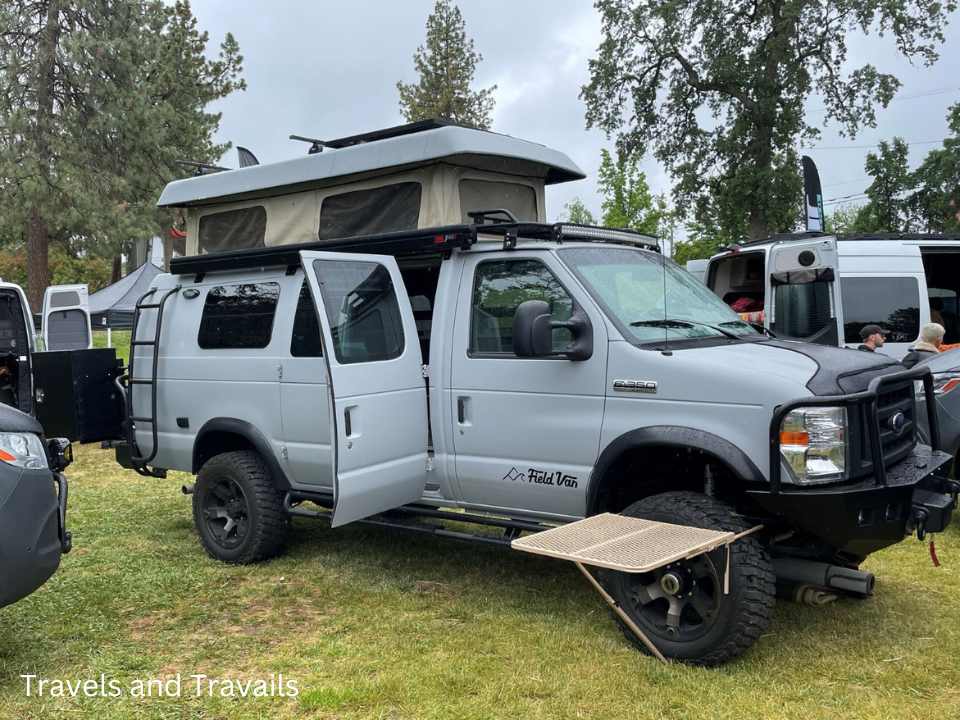
Pop-up roof beds, also known as high-top or pop-top beds, are located in the raised roof of a campervan. They are a unique option that utilizes the space in the van’s roof.
They are raised and lowered using a mechanism and provide a sleeping area that does not take up space inside the van. A ladder typically accesses these types of beds. They are a great option for those who want to maximize space in the van.
They provide ample headroom and storage space in the main living area of the van. Pop-up roof beds can be found in manual and electric versions and customized to fit the camper’s specific needs. They are trendy among van lifers and those who enjoy off-roading and camping in remote locations.
One potential con of using a pop-up roof bed in a campervan is that it may limit headroom in the van when the bed is in use.
Additionally, these beds can be challenging to set up and take down and may require more maintenance and upkeep than other beds. They may also be less secure and stable than other types of beds.
The pop-up roof bed may be heavier than other types of beds, which can be an issue regarding the campervan’s weight.
Getting in and out of a pop-up roof bed can be more difficult and less convenient than other beds, especially for older or less mobile individuals.
Some pop-up roof beds also require ladders or other steps to access, which can be inconvenient to set up and take down.
| Pros | Difficult to install, expensive, not stealthy, and more challenging to get in and out of |
| Cons | Great use of space |
Dinette bed
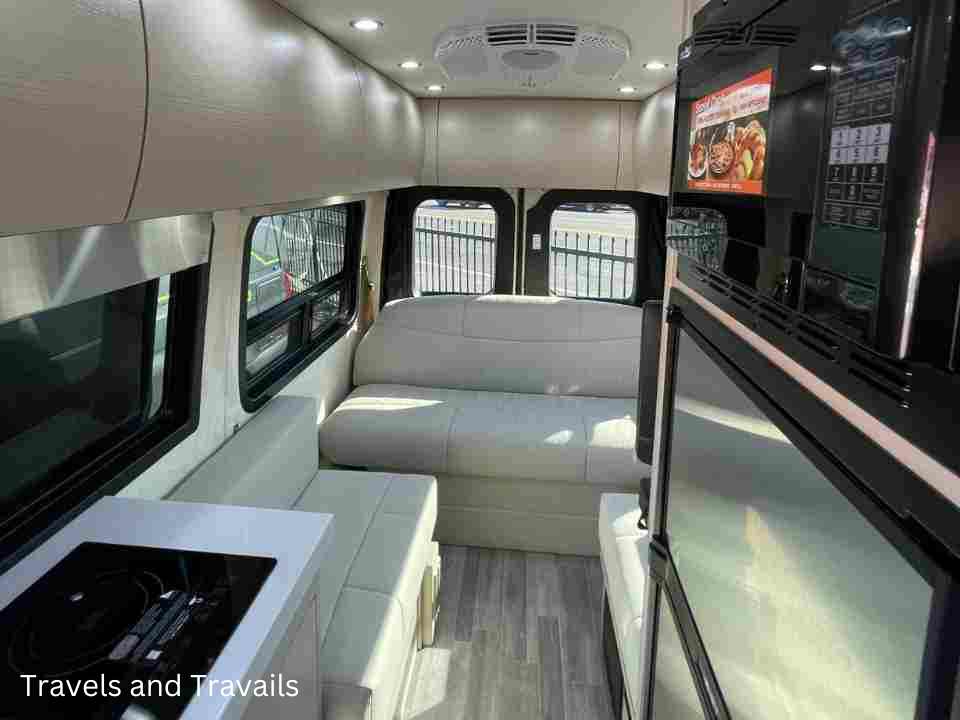
Due to their complexity, Dinette beds are a less common option in camper van builds. They are typically located in the van’s rear and convert into a bed from the dinette seating area.
The bed is created by converting the dinette seating area into a bed. This is often achieved by pulling out a seating bench or flipping up the table.
Dinette beds are a great option for those who want to maximize space and like the flexibility of using the van for multiple purposes.
However, one of the cons of a dinette bed is that it may not be as comfortable as a larger bed and may not be suitable for taller individuals or those with back or joint pain. Additionally, the bed is typically located in the main living area of the van, which means that it may be less private.
Additionally, the conversion process to create the bed may be difficult or time-consuming. Another con is the sleeping area will be in the common area, and the dinette area will be unavailable during sleeping hours.
| Pros | Great space-saving option |
| Cons | Not ideal for comfort, more difficult to construct, not as private |
Bunk Beds
Bunk beds are two beds stacked on top of each other. This is a great option for families or groups of friends traveling together. It allows for more sleeping space in a smaller area.
Additionally, bunk beds can be used to maximize space in a van, as they can be stowed away during the day to create more living space. However, bunk beds may not be the most comfortable option for adults, as the beds are usually smaller than standard beds.
| Pros | Great for families or friends traveling together |
| Cons | Not as comfortable as a regular bed |
Conclusion
In conclusion, the best layout for your campervan will depend on your individual needs and preferences. Consider your priorities, such as sleeping space, living space, and storage, and choose a layout that best suits those needs. Your campervan can be a comfortable and functional home on wheels with the right layout.”
